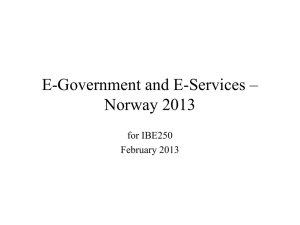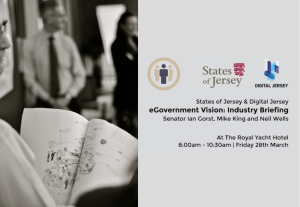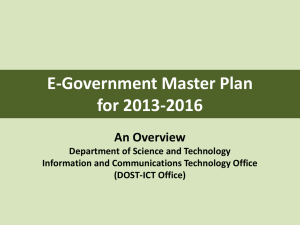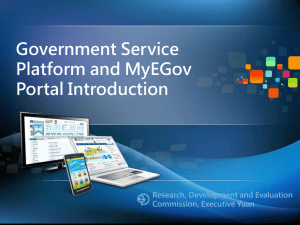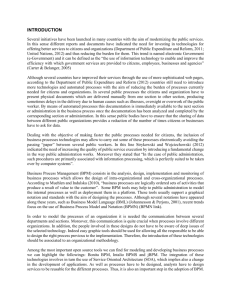e-Government - Australian Public Service Commission
advertisement
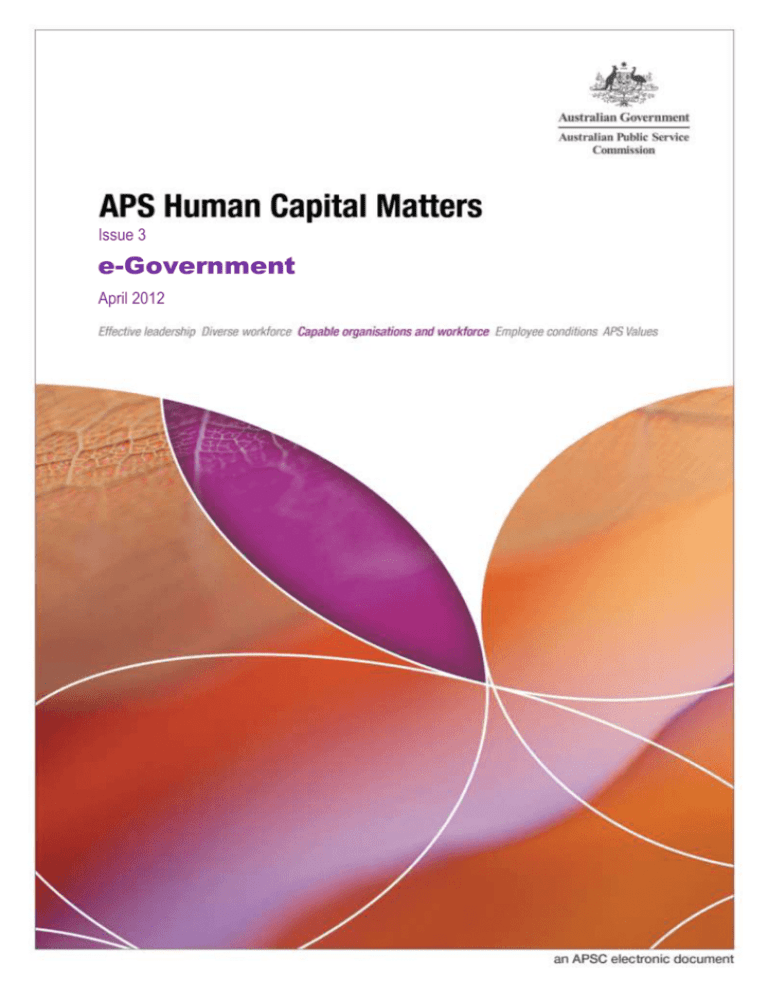
Issue 3 e-Government April 2012 APS Human Capital Matters: e-Government April 2012, Issue 3 Editor’s note to readers Welcome to the third edition of Human Capital Matters for 2012—the digest for time poor leaders and practitioners with an interest in human capital and organisational capability. This edition focuses on the challenges of e-Government within the public sector and between sectors. The term ‘e-Government’ is defined by the World Bank as the use by government agencies of information technologies (such as Wide Area Networks, the Internet, and mobile computing) that have the ability to transform relations with citizens, businesses, and other arms of government. When one considers the challenges facing the APS of the future, in particular the increasing demands of the population as identified in Ahead of the Game: Blueprint for the Reform of Australian Government Administration (2010), the role of e-Government in a future APS is clear. E-Government is an issue of relevance to all government agencies as it has the potential to make transactions between government and citizens, government and business, and within government more efficient and effective. So what does ‘e-Government’ really mean? The growth of electronic means of conducting business can be seen clearly in the existence of entire journals devoted to the topic and one of these (the European Journal of e-Practice) focused an entire issue on Megatrends in eGovernment, including seven different articles on recent thinking and activity in e-Government. A more antipodean flavour is provided by the recent New Zealand Government paper outlining a set of principles and interventions that support cross-agency collaboration in online information management and service delivery. The evolution of e-Government manifests itself as m-Government and is described in a joint OECD/International Telecommunication Union paper that outlines four areas where the use of mobile technology can support the provision of services to citizens. Important elements in implementing any new government services are understanding citizen needs and the capacity to make use of these services; Zickuhr and Smith’s work for the Pew Research Center contains a wealth of information on US citizens’ digital access. The Stratford Institute for Digital Media provides an evaluation of e-Government services in Canada while the UN Public Administration Network (UNPAN) highlights the importance, in these recessionary times, of providing more effective e-responses to citizens’ needs and highlights the important role an internal coordinating function has to play in this. Finally, the US Executive Office of the President provides an analysis of US Federal Government e-Government initiatives, including their objectives, costs and benefits as well as a description of how funding for e-Government programs is distributed. The role of e-Government is expanding for a range of reasons: increased availability of technology (to both citizens and government), growing demands from citizens, and potential improvements in both efficiency and effectiveness of services that can be realised are but a few of the forces driving the advance of e-Government initiatives across the world. This issue of Human Capital Matters will hopefully give readers some idea of the scope of this. Happy reading. About Human Capital Matters Human Capital Matters seeks to provide APS leaders and practitioners with easy access to the issues of contemporary importance in public and private sector human capital and organisational 2 capability. It has been designed to provide interested readers with a monthly guide to the national and international ideas that are shaping human capital thinking and practice. Comments and suggestions welcome Thank you to those who took the time to provide feedback on earlier editions of Human Capital Matters. Comments, suggestions or questions regarding this publication are always welcome and should be addressed to: humancapitalmatters@apsc.gov.au. Readers can also subscribe to the mailing list through this email address. European Journal of ePractice, ‘Megatrends in eGovernment’, No. 13, October 2011. The seven articles in this issue examine central aspects of e-Government growth. They provide a balanced analysis of relatively new e-Government thinking and activity—Web 2.0 and mGovernment—and long-standing aspects such as simplification, citizens’ involvement and trust. The first government websites were established some 15 years ago, and, as the editorial makes clear, early assumptions were that the move toward e-Government would follow a single linear developmental path. These early views—shaped by what the journal dubs ‘technological determinism’—tended to emphasise the technological dimensions of e-Government suggesting a rather automatic set of outcomes and benefits. Experience has demonstrated, however, that neither of these assumptions is necessarily accurate. Project implementation is more complex than anticipated; problems and barriers are not primarily technological, but also organisational, political, legal, and even cultural. In addition, successful solutions to e-Government challenges usually depend on local conditions. The editorial argues that current and future e-Government initiatives are likely to be shaped by different orientations and goals. This issue of the journal aims to identify and analyse some of the broad trends and paradigms characterising today’s international e-Government landscape—some of which may even determine the future of governments themselves. Jose Luis Blasco and Modesto Fabra discuss the evolution of e-Government initiatives in Spain, and focus particularly on the role of regulation and legal frameworks in stimulating and guaranteeing electronic relationships between citizens and governments. They identify three enduring areas for attention in ensuring successful e-Government outcomes: transparency, administrative cooperation and simplification. Mirlinda Batalli’s article also emphasises the need for simplification. She argues that its positive consequences go far beyond increasing the efficiency and productivity of administrative bodies. In the political arena, it can lay the foundations for improved accountability and transparency, and generate greater citizen trust in government. Ms Batalli also discusses the strengths and weaknesses of past and present ICTbased strategies which have been designed to address the challenges of simplification. Alexander Heichlinger, Cristina Borrell and Julia Bosse analyse the applications presented in 2009 at a European award competition for innovative public sector projects. The most frequently-implemented successful approaches were improving back-office and upgrading organisational processes and involving users in the design and planning phase of projects. Thomas Zefferer and Peter Teufl examine one of the most important emergent themes in eGovernment: m-Government, a concept which refers to the use of mobile platforms and devices for public services. They focus particularly on the role that Smartphones can play in providing new opportunities for improving existing services or creating new ones. The authors also provide an action plan designed to assist in forging secure and usable smartphone-based m-Government services. Karunakaran Sabarish discusses an m-Government project in the state of Kerala, India, 3 more specifically, the approaches implemented to identify services and design solutions to eGovernment challenges. Mayo Fuster explores a growing social phenomenon on the Internet that has attracted much scholarly attention recently, but remains largely absent from the e-Government literature: Online Creation Communities (also known as Peer Production Systems). Although they originated some two decades ago around the design of open source software, they have expanded increasingly to encompass other domains of production. The article focuses on the new governance approach adopted by these communities, one which fosters, on a large scale, participation and democratic decision-making within a digital environment. Marijn Plomp and Robbin te Velde analyse Web 2.0 and its place in e-Government. Unlike Peer Production, Web 2.0 has received much attention from public administration practitioners and experts. Using case studies of several local governments around the world, the authors recommend that a more objective assessment of the actual value added by social media in the public administration context be undertaken. The ‘European Journal of ePractice’ is a peer-reviewed European Commission-sponsored publication launched in November 2007. It focuses on all aspects of ‘e-Transformation’. New Zealand Government, Department of Internal Affairs, Office of the Government Chief Information Officer (GCIO), ‘Rethink Online: A New Approach for Government Use of and Investment in Online Channels’, July 2011, 33 pp. The paper outlines principles and strategies for enhancing government utilisation of and investment in ‘online channels’, namely, the many individual locations where government information and services are provided to citizens using Internet technologies. These include websites, online feeds and web services, mobile technologies and use of third party websites and social media. The term does not encompass non-customer facing enablers such as data exchange between agencies and back-end service infrastructure; nor does it include business systems used within agencies (e.g. email and remote desktop access). More broadly, the authors advocate a new approach to online service provision, one marked by a move away from the existing focus on single agency initiatives and investment toward cross-agency approaches in order to achieve three principal outcomes: 1) better citizen experience; 2) improved value for money; and 3) increased strategic agility. The document is intended to refine and better direct the Government’s focus on online channels so as to address existing fragmentation and inefficiency in online information and service delivery; and to better support government in meeting people’s expectations and its own changing online management needs. Accordingly, the paper sets out four principles and nine strategic interventions required to ensure that cross-agency collaboration in online information management and service delivery becomes the norm rather than the exception. The four principles and their concomitant strategies are set out below: Principle 1: Coordinate how online is managed across government (1. Set up effective cross-agency planning for online delivery; 2. Have a single point of contact and responsibility for online in every agency; and 3. Measure and report the business value and quality of online channels). Principle 2: Share capability and adopt common approaches (4. Concentrate skill in centres of expertise, for use by all agencies; and 5. Share technology components, designs and contracts across government). 4 Principle 3: Design and deliver around people’s needs (6. Cluster online information and services around shared topics and audiences, not agencies; and 7. Bring all ‘government to government’ information and online tools together). Principle 4: Partner outside of government for better online delivery (8. Open up access to information, non-personal data and services; and 9. Partner with third parties and communities for effective government online delivery). The Office of the Government Chief Information Officer (GCIO) provides guidance and support to the Government in implementing its ICT strategies and initiatives. OECD/International Telecommunication Union, ‘M-Government: Mobile Technologies for Responsive Governments and Connected Societies’, OECD Publishing, 2011, 154 pp. The report examines the phenomenon of mobile phone technology use—what is quickly becoming the most rapidly adopted technology in history and the most popular and widespread personal technology in the world. Mobile phones also play an increasingly important role in providing access to the Internet. According to the International Telecommunication Union (ITU), access to mobile networks is now available to 90% of the world’s population, and to 80% living in rural areas. In OECD nations, mobile broadband subscriptions rose by a compounded annual growth rate of 20% between 2007 and 2009. As the OECD points out, governments are increasingly turning to what is being termed ‘m-government’ as a tool for improving services through citizen engagement. The interoperability of mobile applications, which support quick access to integrated data and location-based services, paves the way for innovative public sector governance models—also called ‘mobile governance’ or ‘m-governance’, which is based on the use of mobile technology in support of public services and information delivery. The report defines ‘m-government’ as ‘the adoption of mobile technologies to support and enhance government performance and foster a more connected society.’ However, it stresses that the emphasis here should not be on the ‘m’; rather the focus must be on public sector and enduser needs (those of both citizens and businesses) if technology is to be used to bring about better public sector ways of working and improved service delivery. The report acknowledges that ‘mgovernment’ is at an early stage of development in numerous jurisdictions, and, in many instances, that it is still part of an overall strategy of public sector modernisation and enhanced public service delivery. Nevertheless, it is clear that ‘m-government’ is already becoming a significant driver of, or adjunct to, public sector change. Accordingly, the report identifies four areas in which ‘m-government’ could be (or is already being) employed to strengthen public sector capability and enhance outcomes for citizens: Innovating service delivery: (supporting governments who recognise that they have reached their service delivery limits with current approaches and who wish to design and deliver innovative new services via higher levels of civic engagement in policy development and democratic decision-making). Empowering digitally deprived citizens: (making it easier for those now in large part digitally excluded to access a wide range of government services (e.g. improved m-health and emergency assistance, medical notifications and alerts, more effective banking and cash transaction arrangements, enhanced delivery of educational content to students)). Identifying partnerships and exchange between the public and private sectors: (sophisticated mobile technologies are being employed to establish more efficient business processes in the public sector, through real-time communication and quick data access, and more 5 agile and mobile public sector workforces; this is a key driver in exploring new public-private sector partnership models and strengthening collaboration in devising solutions to service delivery challenges). Enhancing public sector performance and good governance: (significant opportunities for governments to reduce costs, improve communication and data exchange, expand service provision and create greater digital equality; this makes ‘m-government’ a significant tool in improving governance and reducing global poverty). The report argues that understanding the underlying concepts and motivational factors which explain the emergence of ‘m-government’ is crucial if governments are to set priorities and formulate policies that maximise the opportunities offered by ‘the next generation of public services’ of which ‘m-government’ is such a key part. The OECD’s mission is to promote policies designed to improve the economic and social wellbeing of peoples across the globe through research, collaboration and other activities aimed at strengthening good governance. The International Telecommunication Union is the specialised UN agency responsible for enhancing international ICT outcomes. Pew Research Center’s Internet & American Life Project, ‘Digital Differences’, Pew Research Center, Washington, D.C., April 2012, 41 pp. Although this report on Internet use across the USA, by two Pew Internet research specialists, Kathryn Zickuhr and Aaron Smith, does not focus directly on government’s use of e-tools in providing services to citizens, it nevertheless contains extensive survey data and analysis which would be useful to public administration practitioners in framing their ICT policies and practices and serving citizens. The report is based on a Pew tracking survey which was in the field between 25 July and 26 August 2011. It was administered by landline and cell phone, in English and Spanish, to 2,260 adults aged 18 years and over (Pew conducted its first such survey in 2000). The survey’s main findings about the state of digital access across America were as follows: One in five American adults does not use the Internet (those least likely to do so are senior citizens, those who chose to take the survey in Spanish rather than English, adults with less than a high school education, and those living in households earning less than $30,000 per year). Of all adults surveyed, 78% replied that they use the Internet (up from 47% in 2000) (80% of men, up from 50% in 2000; 76% of women, up from 45% in 2000). Age was a major factor in shaping usage: 18–29 years age group (94% use the Internet, up from 61% in 2000); 30–49 years (87%, up from 57% in 2000); 50–64 years (74%, up from 41% in 2000); and 65 years and over (41%, up from 12% in 2000). Almost half of those who said they did not use the Internet indicated that their main reason for not going online is that they don’t think the Internet is relevant to them. The 27% of American adults living with disability are significantly less likely than adults without a disability to go online (54% vs. 81%); 2% of adults have a disability or illness that makes it difficult or impossible for them to use the Internet at all. Internet access is no longer synonymous with going online using a desktop computer. Today, 88% of American adults have a cell phone, 57% have a laptop, 19% own an ebook reader, and 19% have a tablet computer—about six in 10 adults (63%) go online wirelessly with one of these devices. 6 The mobile phone has become the dominant e-communication tool overall, but there are discernible differences even here: both African-Americans and English-speaking Latinos are as likely as white Americans to own a mobile phone, but are more likely to use their phones for a wider range of activities. The Pew Research Center is a Washington, D.C.-based think tank that focuses on analysis of national and global societal trends through ambitious survey work and reporting. The Pew Internet & American Life Project, which was established in 2000, looks at the role of the Internet in American life. The Stratford Institute for Digital Media, ‘Becoming a Digital Nation: An Evaluation of Provincial and Territorial e-Government Initiatives’, April 2012, 89 pp. The report evaluates Canada’s provincial and territorial e-Government initiatives by exploring online services and information provision and the effectiveness of online citizen engagement activity. It has two purposes: 1) to serve as an impartial, data-driven analysis which can support provincial and territorial government Chief Information Officers in improving public sector eservices to citizens; and 2) to provide a benchmark for future studies that measure e-Government progress in each Canadian jurisdiction. ‘Becoming a Digital Nation’ does not focus on the relative ratings of jurisdictions but rather identifies the best practices emerging across governments. The online suite of services of Canada’s 13 provincial and territorial governments are also compared with those of three international jurisdictions—Massachusetts, California and Wales. Using a three-tiered evaluation framework developed through national stakeholder consultations and modelled in part on existing mechanisms for evaluating e-Government services, the report looks at how well citizens are able to complete basic government services online (e.g. changing one’s address on a driver’s license); how effectively they can access government information online (e.g. researching available funding options for starting a business); and how well they are able to engage and interact with their government online (e.g. ‘tweeting’ in response to a significant civic issue on an official government Twitter feed). The best performers in each category were: Quebec for its provision of citizen-centric online services; Ontario for its provision of integrated online information; and Alberta for its effective use of social media to engage with citizens online. Across all categories, British Columbia was the leader. Of the three assessment categories, the study found the greatest variation to be in that of online engagement, with only six of the 13 jurisdictions employing all three evaluated social media platforms to connect with citizens. The study also indicated that the Canadian jurisdictions compared well with their foreign comparators: four provinces were ahead of, and the other nine were competitive with, their international counterparts. The authors acknowledge that their report offers only a baseline measurement from citizens’ perspectives of how they access government services, find government information, and engage with their government online (albeit an ambitious one). Accordingly, they recommend that a more comprehensive evaluation be undertaken based on an internal analysis and assessment of issues specific to government web development (e.g. security, digital archiving, e-Procurement). They also stress that future studies should take account of advances made as government websites incorporate newer online tools and technologies into their existing website structures. 7 The Stratford Institute for Digital Media is a Canadian organisation which conducts research and facilitates consultation about Canada’s digital developments and prospects. Brainmaven Research Inc. is a research consultancy based in Vancouver, British Columbia. United Nations Public Administration Network (UNPAN), ‘E-Government for the People’ (2012 Global E-Government Survey), February 2012 (Report 143 pp; Annexes 19 pp). The survey on which the report is based was conducted between December 2011 and February 2012. It explored the inter-linkages between e-Government and sustainable development efforts. As well as setting out the United Nations e-Government rankings for 2012, the report analyses how governments are employing e-Government policies and programs to support sustainable development efforts worldwide. The report finds that progress in online service delivery continues in most nations. Countries are putting in place e-Government initiatives and ICT applications aimed at enhancing public sector efficiencies and improving governance systems. Among the e-Government leaders, innovative technology solutions have gained special recognition as a means of revitalising lagging economic and social sectors. The overall finding of the 2012 survey is that, while it is important in today’s recessionary international climate to continue the focus on service delivery, governments must increasingly begin to rethink their e-Government and e-governance approaches. In doing so, they should focus more on developing and facilitating integrated e-responses to citizens’ concerns. The presence of a national coordinating authority with this role, for example, could help greatly to overcome internal barriers and focus minds on citizen concerns and needs. The report also argues that e-Government provides public administration practitioners with powerful tools for grappling with problems of social equity and the digital divide. The caveat here is that governments must devise effective channels of communication that fit national circumstances while at the same time taking steps to increase usage of online and mobile services in order to realise their full benefit to citizens. The E-Government Development Index lists the top 20 world e-Government leaders for 2012 as follows: 1) Republic of Korea; 2) Netherlands; 3) United Kingdom; 4) Denmark; 5) USA; 6) France; 7) Sweden; 8) Norway; 9) Finland; 10) Singapore; 11) Canada; 12) Australia; 13) New Zealand; 14) Liechtenstein; 15) Switzerland; 16) Israel; 17) Germany; 18) Japan; 19) Luxembourg; and 20) Estonia. Three of the top 20 nations are from Asia, with the region as a whole having a higher level of e-Government development than the world average (the Asian and world leader, the Republic of Korea’s rating was more than double the world average eGovernment score). The leaders in Oceania (14 nations surveyed) were Australia, New Zealand, Fiji and Tonga. Other ratings included Vanuatu (ninth place), Marshall Islands (11), Solomon Islands (13) and Papua New Guinea (14). This year’s survey found that nations have begun to move from a decentralised single-purpose organisation model of e-Government to an integrated and unified whole of government model focused more on citizens. This approach fosters stronger institutional linkages by means of interconnected departments and divisions; better governance systems; and improved service delivery to the public. However, the efforts of most countries at all levels of development are still variously affected by overly complex e-Government development plans, lack of (or poor) infrastructure and human resources capacity, and a gap between e-services supply and demand. Low-income countries, in particular, continue to have to contend with traditional barriers to ICT investment such as a paucity of technical skills, high technology costs and ineffective government regulation. 8 UNPAN, established in 1999, is a major UN program designed to assist developing countries to respond to the digital challenges they face. The Global E-Government Report provides an assessment of e-development both between nations and within individual countries. It also identifies digital trends of significance. USA, Executive Office of the President of the United States, ‘Report to Congress on the Benefits of the President’s E-Government Initiatives Fiscal Year 2011’, 294 pp (key summary details, pp. 1–44). This report, compiled by the US Office of Management and Budget (OMB), contains detailed analysis of each Federal Government e-Government initiative, its related objectives, costs, benefits, risks and development status as well as sources of distribution of e-Government funding. The information set out in the report is aligned with the activities described in the President’s 2011 Budget. The first section, ‘Summary of E-Government Initiatives’, provides an overview of all E-Government and Line of Business (LoB) initiatives. Initiatives are broken down into five focus areas (‘portfolios’), including the LoBs. These five areas (and a representative example of e-activity undertaken within each category) are listed below: Government to Citizen: (Managing Partner: Department of Labor (DOL))—Benefits.gov is the Federal Government’s official benefits website which provides all citizens with information and eligibility prescreening services for more than 1,000 federally funded benefit and assistance programs. It also creates and hosts multiple other websites on behalf of its federal partner agencies (e.g. GovLoans.gov), each of which leverages Benefits.gov’s existing architecture, infrastructure and management framework. More than 43 million citizens have completed a free online questionnaire designed to inform them of their eligibility to access government benefits. Government to Business: (Managing Partner: Small Business Administration (SBA))—SBA’s mission is to maintain and strengthen the nation’s economy by assisting small business, in particular, to address the requirements of government regulation. The mechanism for doing so is the Business Gateway, which is designed to ensure easier citizen access to information and reduce the burden of, and help people comply with, government regulations. The Gateway utilises the Internet to transform government into a more innovative, reliable, and citizen-centred partner in improving efficiencies for entrepreneurs and small business owners. It signifies a major shift in distributing information and services, one designed in the interests of financial savings, citizen engagement and collaboration. Government to Government: (Managing Partner: Department of Homeland Security (DHS))— The Disaster Management (DM) initiative benefits all levels of government by facilitating greater collaboration within and between agencies in responding to emergencies. The DisasterAssistance.gov portal provides timely planning and response information to those charged with special responsibility for dealing with disasters. Internal Efficiency and Effectiveness: (Managing Partner: Office of Personnel Management (OPM))—The Enterprise Human Resources Integration (EHRI) program supports the strategic management of human capital by providing agency customers with access to timely and accurate Federal Government workforce data. A key EHRI initiative is the electronic Official Personnel Folder (eOPF), a web-based application that is capable of storing, processing, and displaying the OPFs of all current, separated and retired Federal Government employees. It will ultimately encompass a public sector population of more than 1.9 million people; and is intended to replace the existing manual HR process by automating Federal Government HR arrangements, thereby creating a streamlined HR system for all federal employees. 9 Lines of Business: (Managing Partner: Department of Education (ED))—The aim of the Budget Formulation and Execution LoB is to create ‘a budget office of the future’ by promoting information sharing across government agency budget offices and building a ‘community of practice’ so as to achieve greater efficiency and effectiveness in formulating and executing the Federal Government’s Budget. The Executive Office of the President (EOP ) consists of the US President’s staff—policy and administrative—and is headed by a Chief of Staff. 10



